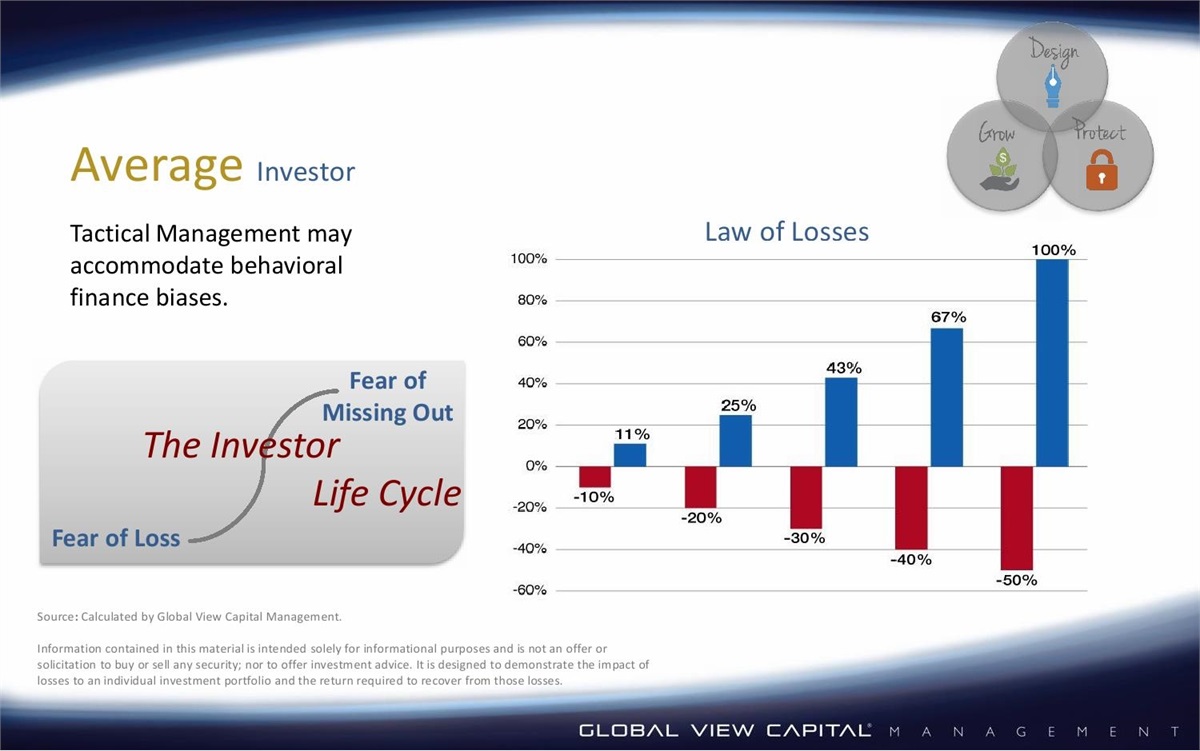Instead of riding the market to its top, only to ride it back down during severe market declines, having a tactical methodology that provides a defensive component to your portfolio may help your portfolio do better over the long term. Tactical management is when there’s a third-party firm who monitors an account on a daily basis, and upon discretion, makes adjustments to the account in response to market conditions, putting a ‘defensive’ component to one’s strategy when it is justified.
Schedule an Appointment — Talk with a Fiduciary Advisor
Active & Tactical Management
This can be particularly beneficial during periods when there is high volatility or uncertainty in the markets, such as during the 2008 financial crisis, or most recently, during the COVID-19 pandemic that impacted almost every facet of American lives. Although this makes sense for most people, having access to solutions like this is another story. Tactical management is not usually available for most people unless they have significant account balances. Our firm has developed a technology platform that makes this available at practically all levels, especially where the help is most needed: those who are often overlooked.
Why Active and Tactical Management?
Below are four charts that will help illustrate some key points. The first chart illustrates the concept of hiring a tactical manager, wherein we simply applied the long-term trend signals of AdvisorGuide—a research firm that specializes in providing daily, objective market insight to investment professionals—to show that during certain periods, especially during times of severe market declines, a portfolio may warrant a “defensive move.”
In this case, the chart shows the portfolio being invested in Treasurys during those down periods. So, instead of riding the market to its top, only to ride it back down during severe market declines, having a tactical methodology such as the one shown in this chart that provides a defensive component to your portfolio may help your portfolio do better over the long term.
The next chart shows the effect of “The Law of Losses,” showing how much return one would need to get in order to recover from certain levels of losses. The key thing to note here is that the steeper the loss, the greater the return needed just to bring one’s portfolio back to its previous levels.
The question to ask here would be: since the financial crisis of ’07-’08, how many people do you think really would have made the 100%-type of returns needed to get back to where they were prior to the crisis? So, as important as it is to make money, it is equally important to place an emphasis on protecting what you have. Because if you experience significant declines, as many did back in 2008, those declines could have a significant impact on your retirement nest egg and its ability to provide your future needs.
The next two charts show the power of compound Interest (which Einstein marveled at), followed by the importance of avoiding market losses. Avoiding losses is huge. Notice how significantly your nest egg can be impacted even if your portfolio achieved the same returns in all years—except that historically once in every 12 years there’s a 50% loss! Note the enormous difference in each of the ending balances in the same timeframe.
This is why it may be prudent for you to consider our Active and Tactical Money Management service to allow you to participate when markets are good, but help provide the defense your portfolio needs when market conditions change for the worse. So, what’s the main lesson? While you can’t control the market, you can hire a tactical manager. Please schedule a time to learn more.
We have the expertise, experience, and capacity to provide this guidance to you.
If there is a facet to your current plan you would like to have evaluated or done better, let us help you. If you’re like most companies, you or your team are likely already inundated with day-to-day ongoing responsibilities, so allow us to save you time by letting our team do the research on your behalf.
Here’s the Best Part:
Evaluating plans and making the appropriate recommendation(s) is complimentary
The 10 Best Kept Secrets to Building Wealth
What if you had a simple guide to help you not just get a better handle on your finances, but also prosper in your life? Download our guide today.



![f6bf9487-ebb0-46e0-b955-62cd348bf296[1] f6bf9487-ebb0-46e0-b955-62cd348bf296[1]](https://chadalbano.com/wp-content/uploads/2023/12/f6bf9487-ebb0-46e0-b955-62cd348bf2961-600x400.jpg)
![dbc1ec26-0f0c-488f-a57a-936d22e788ed[1] dbc1ec26-0f0c-488f-a57a-936d22e788ed[1]](https://chadalbano.com/wp-content/uploads/2023/12/dbc1ec26-0f0c-488f-a57a-936d22e788ed1-600x400.png)


